
S.Warren. Designing organic syntheses
..pdf
127
396. Revision Problem 3: House (J. Org. Chem., 1965, 30, 1061) wanted to study intramolecular Diels-Alder reactions and wanted molecules like TM 396 in which n is 3 or 4, so that the product will have a 5 or 6 membered ring if the reaction works. It would obviously be a good thing if the synthesis can easily be modified to make other size rings as well. What do you suggest?
CO2Me |
CO2Me |
|
|
|
? |
|
|
TM 396 |
( CH2 ) n |
|
|
( CH2 ) n |
A |
||
|
_______________________________________
397. Analysis: If we take out the central portion of the molecule we can use any size of n we want. The most obvious method is two successive Wittigs:
CO2Me |
B |
CO2Me |
|
Ph3P |
CHO |
|
CHO |
|
|
|
|
( CH2 ) n |
|
( CH2 ) n |
|
|
Ph3P A
If we use the rather unreactive B first we should be able to react one aldehyde at a time. The various dialdehydes are available or can be made by the usual 1,n-dicarbonyl routes.
Synthesis: This is what House did:
Br |
CO 2Me |
+ CO2Me |
MeO- |
CO2Me |
Ph3P |
|
Ph3P |
|
Ph3P |
|
|
|
|
CHO |
Br |
|
|
|
(CH2 )3 CHO |
+ |
|
MeLi |
OHC |
CO2Me |
Ph3P |
|
|
 CO2Me
CO2Me
TM 396 (n = 3)
To complete the story, when this molecule was heated an intramolecular Diels-Alder reaction did indeed take place to give a new fivemembered ring, (396A, n=3).
_______________________________________
398. Revision Problem 4: Musks are compounds which have some pleasant smell themselves, but function chiefly by retaining and enhancing the perfume of other compounds. How might ‘celestolide’, a modern musk, (TM 398) be made?
TM 398
O
_______________________________________
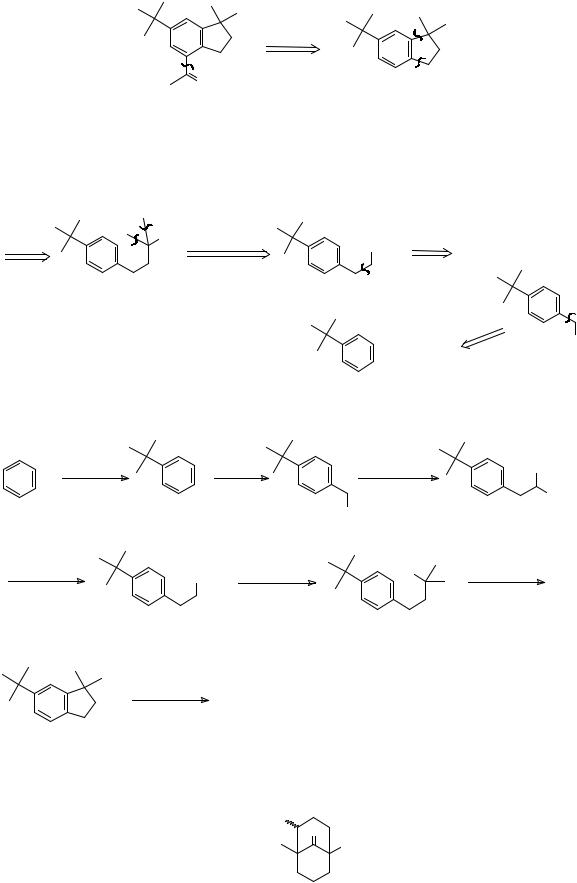
128
399. Analysis: The one functional group is something of a red herring since we shall put in the acetyl side chain by a Friedel-Crafts reaction on the real target molecule, 399A:
a
F - C
b
O
399 A
This will clearly be made somehow by disconnections a and b but the order of events is important. We must disconnect first, that is synthesise last, the bond with the ‘wrong’ orientation – i.e. a, meta to the t-butyl group. The reaction will then be intramolecular and orientation doesn’t matter. This gives us 399B, and I show one possible route from that.
|
OH |
Grignard |
|
CH2(CO2Et)2 |
|
a |
CO2Et |
+ |
|||
|
|||||
|
|
||||
|
|
|
|
F - C
399 B
Cl
+ CH2O
Synthesis: This route has been carried out successfully (Rec. Trav. Chem., 1958, 77, 854). Note that no AlCl3 is needed for Friedel-Crafts alkylation with easily formed t-alkyl compounds.
|
|
EtO- |
CO2Et |
t - BuOH |
CH2O |
CH2(CO2Et)2 |
CO2Et |
H+ |
HCl |
|
|
Cl |
|
||
1. HO-/ H2O |
CO2Et |
HO |
|
2. H+/ heat |
|
|
|
MeMgI |
|
conc. H2SO4 |
|
3. EtOH / H+ |
|
|
|
MeCOCl
TM 398
AlCl3
_______________________________________
400. Revision Problem 5: This molecule (TM 400) was used by Raphael in his synthesis of the natural product clovene. How could you make it.
HO
O
CO2Et
TM 400
_______________________________________
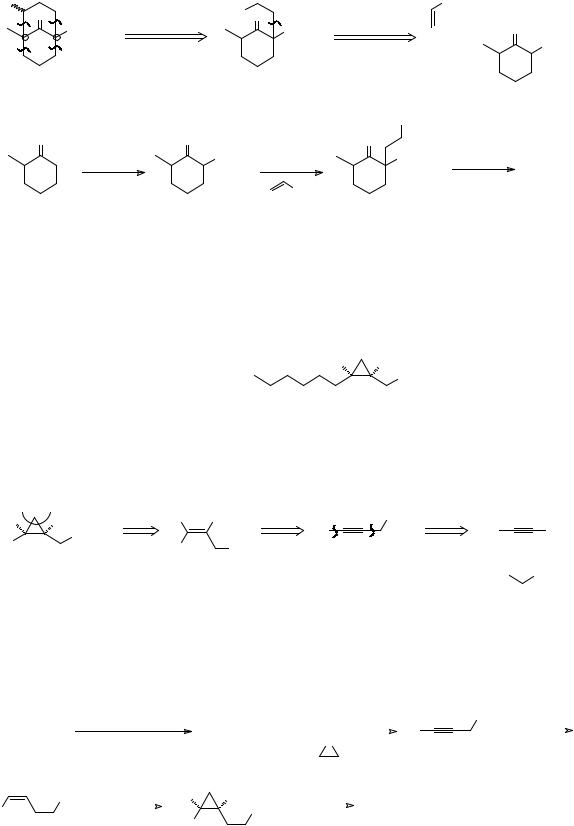
129
401. Analysis: We want to disconnect any of the bonds to the common atoms • to give us a simple six-membered ring. We can best disconnect bond a as it is part of a 1,3-di oxygenated system:
HO |
O c |
|
OHC O |
|
CHO |
|
a |
a |
1,5 - di CO |
+ |
|
||
|
CO2Et |
CO2Et |
O |
|||
|
|
|
||||
b |
d |
1,3 - di CO |
|
|
|
CO2Et |
|
|
|
|
Synthesis: The starting material is similar to TM 100, so we shall use the same method:
|
|
|
|
CHO |
|
|
O |
O |
|
|
O |
|
|
|
EtO- |
CO2Et |
EtO- |
CO2Et |
H2SO4 |
TM 400 |
|
|
|
|
|
|
|
|
ClCO2Et |
|
CHO |
|
|
|
Only isomer A will be formed as the alternative cannot give a stable enolate anion (see frame 101). This is nearly the synthesis used by Raphael (Tetrahedron, 1962, 18, 55; Proc. Chem. Soc., 1963, 239).
_______________________________________
402. Revision Problem 6: Cascarillic acid occurs naturally in Euphorbiaceae plants (spurges). How could you synthesise it?
H |
H |
Cascarillic acid |
CO2H |
_______________________________________ |
|
403. Analysis: the small ring will dominate the strategy, and only one disconnection will make the stereochemistry secure. Writing R = n-hexyl:
|
|
|
cis olefin |
|
|
RBr |
|
|
|
|
|
+ |
|
H |
H |
H |
H |
FGI |
CO2H |
|
R |
|
CO2H |
|
R |
H |
H |
|
R |
CO2H |
|
|
+ |
|
|
|
|
|
|||
|
|
|
A |
|
Br |
CO2H |
|
|
|
|
|
Synthesis: The CO2H group spells trouble. We would certainly have to use an ester, but the α-bromoester is too reactive to use with an acetylene. Also there is a danger that the double bond in A will move into conjugation. We can get round all these problems with an epoxide and then oxidise at the end:
|
|
|
|
|
1. Na , liquid NH3 |
|
|
|
|
|
|
1. Na , liquid NH3 |
|
OH |
H2 |
||||
H |
|
|
|
H |
R |
|
|
|
H |
|
R |
||||||||
|
|
|
|
2. n-HexBr |
|
|
|
2. |
O |
Pd , C |
|||||||||
|
|
|
|
|
|
|
|||||||||||||
|
|
|
|
|
|
|
|
|
|
|
|
||||||||
|
|
|
|
|
|
|
|
|
|
|
|
|
|
|
|
|
|
|
BaSO4 |
|
|
|
|
OH |
|
CH2I2 |
H |
|
H |
|
oxidise |
|
|
||||||
R |
|
|
|
|
|
|
|
OH |
|
|
|
cascarillic |
acid |
|
|||||
|
|
Zn - Cu |
|
|
|
|
|
|
|
||||||||||
|
|
|
|
|
|
|
|
|
|
|
|
||||||||
|
|
R |
|
|
|
|
|
|
|
|
|
|
|
||||||
|
|
|
|
|
|
|
|
|
|
|
|
|
|
|
|
|
|||
88% |
88% |
|
_______________________________________
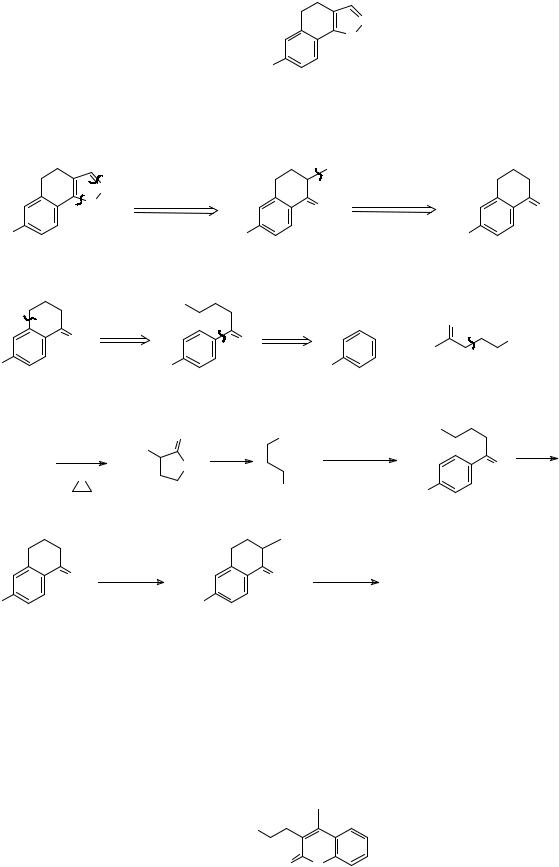
130
404. Revision Problem 7: TM 404 was needed as an intermediate in a steroid synthesis. How might it be made?
N
O
TM 404 |
MeO |
|
_______________________________________
405. Analysis: Taking the heterocyclic part first, we can remove the two heteroatoms as hydroxylamine (the approach of frames 258-261) to give us a 1,3-dicarbonyl compound.
|
|
|
|
CHO |
|
O |
N |
C - N , C - O |
1,3 - di CO |
|
|
|||
|
|
O |
O |
|
|
|
|
||
MeO |
|
|
MeO |
MeO |
|
|
|
|
A |
This starting material A (also 224A) is an isomer of the ketone we made in frame 328, and is easy to make using the intramolecular strategy of that frame:
|
|
Cl |
|
|
|
|
|
|
O |
|
O |
O |
+ Cl |
Cl |
|
|
|
etc. |
|
MeO |
A |
MeO |
MeO |
|
Synthesis:
|
EtO- EtO2C |
O |
CO2H |
|
Cl |
|
|
|
1. PCl5 |
|
AlCl3 |
||||
CH2(CO2Et)2 |
HCl |
|
|
||||
O |
|
O |
|
2. PhOMe , |
|
O |
|
|
|
|
|
|
|
||
|
|
|
|
Cl |
AlCl3 |
MeO |
B |
|
|
|
|
|
|||
|
|
|
|
|
|
|
|
|
|
|
|
CHO |
|
|
|
|
O |
EtO- |
|
O |
NH2OH |
TM 404 |
|
|
|
|
|
|
|||
|
|
HCO2Et |
|
|
HCl |
|
|
MeO |
|
MeO |
|
|
|
||
|
|
|
|
|
|
||
This synthesis was first carried out by Velluz, Angew. Chem., 1960, 72, 725. The lactone can be used instead of the γ-chloro acid, see Org. Synth. Coll., 4, 898. Other approaches to A are outlined in J. Amer. Chem. Soc., 1947, 69, 576, 2936 and it is probable that the reaction actually given here – the cyclisation of B – would give a five membered ring instead (J. Chem. Soc., 1956, 4647). The usual, if illogical way to make A is by reduction of β-naphthol methyl ether and oxidation of the product with CrO3.
_______________________________________
406. Revision Problem 8: TM 406 is a synthetic intermediate related to the cannabinoids, naturally occurring hallucinogenic compounds. How could it be synthesised?
EtO2C
TM 406 |
O O |
|
_______________________________________
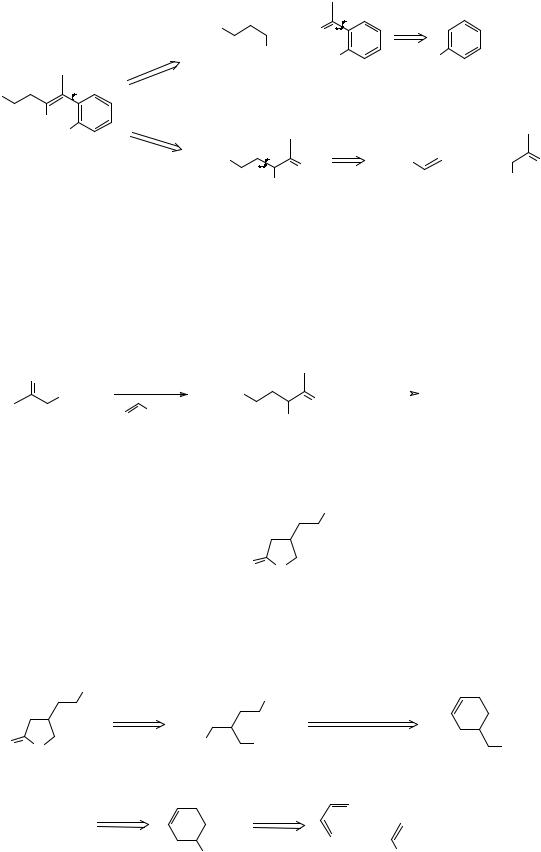
131
407. Analysis: Another lactone! FGI reveals the true TM (A). Our normal disconnection a of an α,β-unsaturated carbonyl compound gives us the 1,5-dicarbonyl compound (B) and the ketone (C) clearly derived from phenol. Alternatively we could disconnect bond b to the keto-ester (D) with the further disconnection shown:
EtO2C |
O |
+ MeCOCl |
+ |
||
HO2C |
HO |
HO |
a |
||
B |
|
C |
a b EtO2C 
HO2C |
HO |
b |
|
A
EtO2C |
O |
EtO2C |
+ |
O |
HO2C |
|
|
|
HO2C |
D
Whichever route we choose, we need ortho substitution. For (C) we can do this via the Fries rearrangement (PhOH + MeCOCl → PhO.COMe which rearranges to C with AlCl3) see Norman p.457-8 or Tedder vol.2 p.214. Howevwr, we still need the right geometrical isomer of A! The other route solves this problem because reaction of D with phenol gives TM 406 directly: ester exchange makes the C-O bond first and the condensation follows. This is the strategy we discussed in frames 319 ff.
Synthesis: Chem.Ber., 1948, 81, 197; J. Amer. Chem. Soc., 1967, 89, 5934: All in two steps!
O |
|
- |
|
PhOH |
|
|
|
EtO |
|
||
CO |
Et |
EtO2C |
O |
|
TM 406 84% |
|
|||||
2 |
|
CO 2Et |
POCl3 |
||
|
|
CO2Et |
|||
|
|
|
|
||
|
|
67% |
|
|
|
|
|
|
|
|
|
_______________________________________
408. Revision Problem 9: Suggest a synthesis for TM 408.
CO2H
TM 408 |
O |
O |
|
|
_______________________________________
409. Analysis: This is a γ-lactone and we spent time considering possible strategies for these compounds in frames 334-348. First open the lactone ring. This gives us a compound with 1,4- 1,5- and 1,6-dioxygenation relationships. I’ll follow the 1,6 through.
|
|
CO2H |
CO2H |
|
|
|
FGI |
reconnect |
|
|
|
|
||
O |
|
HO2C |
OH |
1,6 - di CO |
O |
OH |
Now we are nearly at a Diels-Alder disconnection so a change in the oxidation state to aldehyde or ester is needed:
FGI |
D - A |
+
CO2Et |
CO2Et |
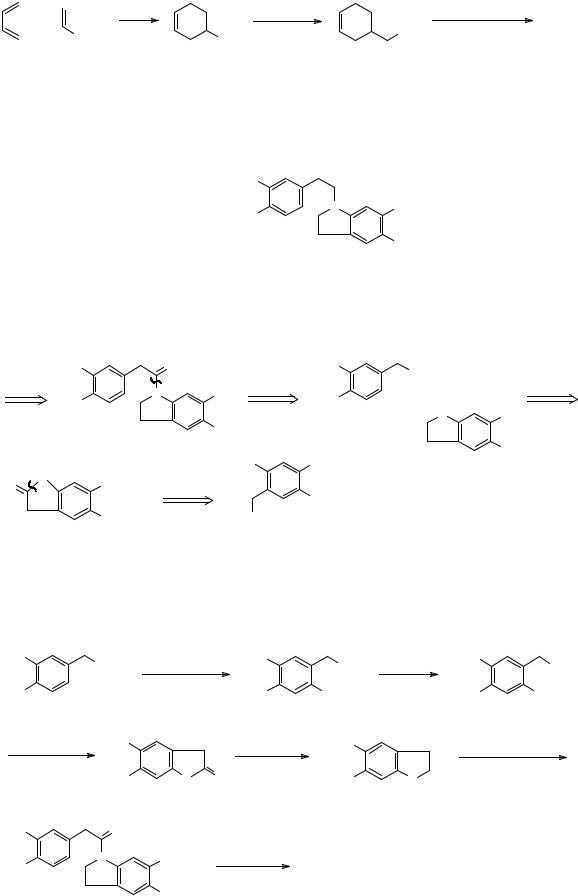
132
Synthesis: As described in Acta Chem. Scand. B, 1977, 31 189.
+ |
LiAlH4 |
1. O3 |
OH |
TM 408 |
|
CO2Et |
2. H2O2 , HCO2H |
|
CO2Et |
|
Cyclisation to give the five-mambered ring is spontaneous.
_______________________________________
410. Revision Problem 10: This compound is an intermediate in the synthesis of an alkaloid. Don’t worry about the half ether aspect – there is a solution to this which will emerge as you go along.
MeO
N OMe
MeO
TM 410 |
OH |
_______________________________________
411. Analysis: The nitrogen atom is clearly the key to the problem and we can put a carbonyl group on either adjacent CH2 group. Strategically we make more progress by using the exocyclic CH2 group first:
|
MeO |
|
O |
|
|
MeO |
|
CO2H |
|
|
|
|
|
|
C - N |
|
|
FGI |
|
|
FGI |
|
N |
OMe |
MeO |
|
H |
||
|
MeO |
|
|
+ |
|
||||
|
|
|
|
|
|
||||
|
|
|
|
|
|
A |
N |
OMe |
|
|
|
|
|
OH |
|
|
|
|
|
|
|
|
|
H2N |
OMe |
|
|
OH |
|
|
H |
|
|
|
|
|
|||
O |
N |
OMe |
C - N |
|
|
|
|
|
|
|
|
|
|
|
|
|
|||
|
|
|
|
|
OH |
|
|
|
|
|
|
|
|
|
|
|
|
|
|
|
|
OH |
|
|
CO2H |
|
B |
|
|
It looks as though we can get B from A (which is used in frame 247) and so the nitro group is the obvious source of the amino group. It will also allow us to hydrolyse one ether specifically by nucleophilic aromatic substitution.
Synthesis: Starting material as in frame 247, then (E. McDonald and R.Wylie, unpublished work at Cambridge 1976-7):
MeO |
|
|
|
|
MeO |
CO2H |
KOH |
HO |
CO2H |
CO2H |
|
|
|
|
|
||||
MeO |
|
HNO3 , HOAc |
|
MeO |
N2O |
H2O |
MeO |
N2O |
|
|
|
|
|
|
|||||
A |
|
|
|
|
|
89% |
|
|
86% |
H2 - Pd - C |
HO |
|
|
|
reduce |
HO |
|
|
A |
HOAc |
|
|
|
|
|
|
|
|
condensing |
MeO |
|
N |
O |
|
MeO |
N |
|
reagent |
|
|
|
92% |
H |
|
|
|
H |
|
|
|
|
|
|
|
|
|
|
|
|
MeO |
O |
|
|
|
|
|
|
|
|
N |
|
OMe |
|
H2 - Pd |
TM 410 |
|
|
|
|
MeO |
|
|
|
|
|
|
|
|
|
OH
_______________________________________
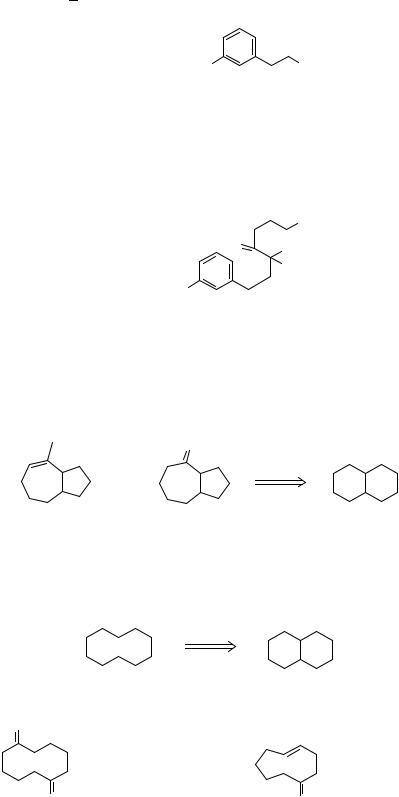
133
M.PROBLEMS IN STRATEGY
412. These are problems without solutions intended to lead you onto more challenging things.
Strategy Problem 1: “The wrong substitution pattern”. Making aromatic compounds m-substituted with two o,p-directing groups is always a problem. What strategies can you suggest? An example (TM 412) is the alkyl halide used in the synthesis of some steroids.
TM 412 |
MeO |
Br |
|
_______________________________________
413. Hint – how do you make any m-disubstituted compound? Which of the two side chains is easier to add? How?
Further development: How would you make TM 413 using the alkyl bromide you have just made? This molecule is obviously on the way to a steroid and you can read more about it in Helv. Chim. Acta., 1947, 30, 1422 and J. Amer. Chem. Soc., 1942, 64, 974.
CO2Et
O CO2Et
CO2Et
TM 413 |
MeO |
|
_______________________________________
414. Strategy Problem 2: “The wrong ring sizes”. We have said nothing so far about seven membered rings. The common arrangement in natural products is a fused seven-five ring system as in the molecules below. They are often synthesised from six-six fused systems because we understand them so much better. What particular six-six fused molecules might you use to make these molecules:
|
|
|
|
O |
|
|
7 |
5 |
or |
7 |
5 |
6 |
6 |
|
You can find some answers in J. Amer. Chem. Soc., 1966, 88, 4113; 1969, 91, 6473; 1971, 93, 1746; Org. Synth. Coll., 5, 277.
_______________________________________
415. Strategy Problem 3: “Too large a ring”. Medium rings are also tricky problems and one way to make them is to cleave a bond in a bicyclic compound, e.g.
What kind of reactions could be used to implement this strategy? How in particular might you make these compounds:
O
TM 415 A |
|
TM 415 B |
O |
O |
note trans olefin |
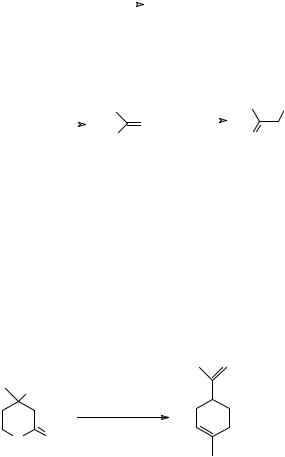
134
You will find some solutions in: J. Amer. Chem. Soc., 1963, 85, 362; 1964, 86, 485, Ber., 1933, 66, 563. Tetrahedron Letters, 1976, 4409.
_______________________________________
416. Strategy Problem 4: “The wrong polarity”. You have seen how important it is to have reagents corresponding to as many synthons as possible. One we haven’t mentioned is the acyl anion R-CO- for which we had one reagent if R=Me (frame 145 if you’ve forgotten!). Can you devise any more general reagents for this synthon? Ideally we should like to make ketones this way:
R1CO- + R2 |
|
Hal |
|
R1CO . R2 |
|
|
_______________________________________
417. This is a very challenging problem indeed. You may find some solutions by setting up two substituents on the carbon atom. For example, how about a substituted Wittig reagent:
- |
+ |
|
|
R1 |
|
|
R1 |
R2 |
|||
+ R2CHO |
|
CHR2 |
|
|
|
||||||
R1C |
|
|
PPh3 |
|
X |
|
O |
|
|||
|
|
|
|
||||||||
|
|
|
|
|
|
|
|
|
|
||
X |
|
|
|
|
|||||||
|
|
|
|
|
|
|
|
|
|||
What could X be for this sequence to be feasible? You will find an account of some modern solutions in Tetrahedron, 1976, 32, 1943 and Synthesis, 1977, 357.
_______________________________________
418. Strategy Problem 6: A labelled compound for biosynthetic studies. Mevalonic acid (TM 418) is an intermediate in the biosynthesis of terpenes and steroids (Tedder, volume 4, p.217 ff). To study exactly what happens to each carbon atom during its transformation into, say, limonene (418A), we need separate samples of mevalonic acid labelled with 14C in each carbon atom in the molecule. This turns our normal strategy on its head since we must now look for one carbon disconnections. You can use reagents like 14CH3I, Na14CN, and 14CH3CO2H. See if you can find approaches to some of the labelled compounds.
OH
|
lemon |
TM 418 |
trees |
O O |
A |
Some solutions can be found in Tetrahedron, 1959, 5, 311, Chem. Abs., 1966, 65, 614, J. Amer. Chem. Soc., 1975, 97, 4144 and see J.W. and R.H.Cornforth in “Natural Substances formed Biologically from Mevalonic Acid”, ed., T.W.Goodwin, Academic Press, 1970, p.5 where all the different routes are explained.
_______________________________________
419. Strategy Problem 7: Synthesis of a single enantiomer. Many compounds such as pharmaceuticals, flavourings, and insect control chemicals must not only have the right relative stereochemistry but must be optically active too if they are to be of any use. Consider the strategy of synthesising one enantiomer:
(a) should you start with an optically active compound? or (b) should you resolve at some point?
if so (c) which is the best point for a resolution?
and (d) what do you do with the unwanted enantiomer?
You can take some examples from this list for your consideration: Target molecules in frames: 133, 135, 152, 216, 242, 249, 251, 377.
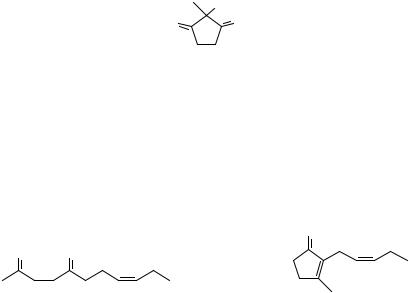
|
135 |
Review Problems |
8 (frame 110) |
|
26 (frame 269) |
|
27 (frame 271) |
|
32 (frame 303) |
Revision Problems |
6 (frame 402) |
γ-Lactones |
9 (frame 408) |
(frames 342-348) |
|
Baclofen |
(frames 349-354) |
Chrysanthemic acid |
(frames 355-370) |
_______________________________________
420.Briefly, the answers to the questions are:
(a)Yes, if one is available – it usually isn’t.
(b)You probably have to.
(c)As early as possible.
(d)Recycle it or use it to resolve something else.
The question of stereochemical control has been a theme running throughout the programme and as you progress to more complicated molecules it becomes more important. This is very clear from many of the syntheses described in Fleming.
_______________________________________
N. PROBLEMS WITH SEVERAL PUBLISHED SOLUTIONS
421. This cyclopentadione is needed to provide ring D in some steroid synthesis. Unlike the corresponding six-membered ring compound it is difficult to make. Can you suggest any solutions?
H
O O
Published Solutions: Bull. Soc. Chim. France, 1955, 1036; 1965, 645; Org. Synth., 1967, 47, 83; J. Org. Chem., 1967, 32, 1236; Angew. Chem., 1967, 79, 97, 378; Chem. Ber., 1967, 100, 2973; 1969, 102, 3238.
_______________________________________
422. Cis-Jasmone (TM 422) is an important ingredient inmany perfumes. There are several obvious disconnections and it may help you to know that cyclisation of the diketone 422A does indeed selectively give cis-jasmone.
O
O O
TM 422 A |
TM 422 |
|
Published Solutions: J. Chem.Soc., 1969 (C), 1016, 1024; Chem. Comm., 1972, 529; Tetrahedron Letters, 1972, 1233; 1976, 4867; 1971, 1569, 2575; 1973, 3267, 3271, 3275; 1974, 3883, 1237, 4223. J. Amer. Chem. Soc., 1964, 86, 935, 936; 1970, 92, 7428; 1971, 93, 5309, 3091; 1972, 94, 8641; 1973, 95, 4446, 4763. Canad. J. Chem., 1972, 50, 2718. J. Org. Chem., 1972, 37, 341, 2363; 1966, 31, 977; 1971, 36, 2021. Chem. Lett., 1972, 793; 1973, 713.

136
Fourteen syntheses of cis-jasmone are given in chart from in ‘Natural Products Chemistry’ ed. K.Nakanishi et. al., Academic Press, New York, 1975, vol.2, p.21.
_______________________________________
423. Juvabione is a substance produced by some conifers in imitation of a hormone in an insect pest. It may be a kind of natural control of the pest as it prevents it reaching maturity.
H |
H |
O |
CO2Me |
Juvabione
Published Solutions: Tetrahedron Letters, 1967, 2515, 4677; 1969, 351; Tetrahedron, 1968, 24, 3127; Chem. Comm., 1968, 1057; Canad. J. Chem., 1968, 46, 1467; J. Amer. Chem. Soc., 1970, 92, 366.
_______________________________________
424. Grandisol, with a four-membered ring, is another insect hormone, the male sex hormone of the boll weevil to be precise. It may also be useful as a highly specific pest control. How might it be made?
H
OH
Grandisol |
H |
|
Published Solutions: Science, 1969, 166, 1010; J. Amer. Chem. Soc., 1970, 92, 425; 1974, 96, 5268, 5270, 5272; 1976, 98, 4594; J. Org. Chem., 1972, 37, 54.
_______________________________________
